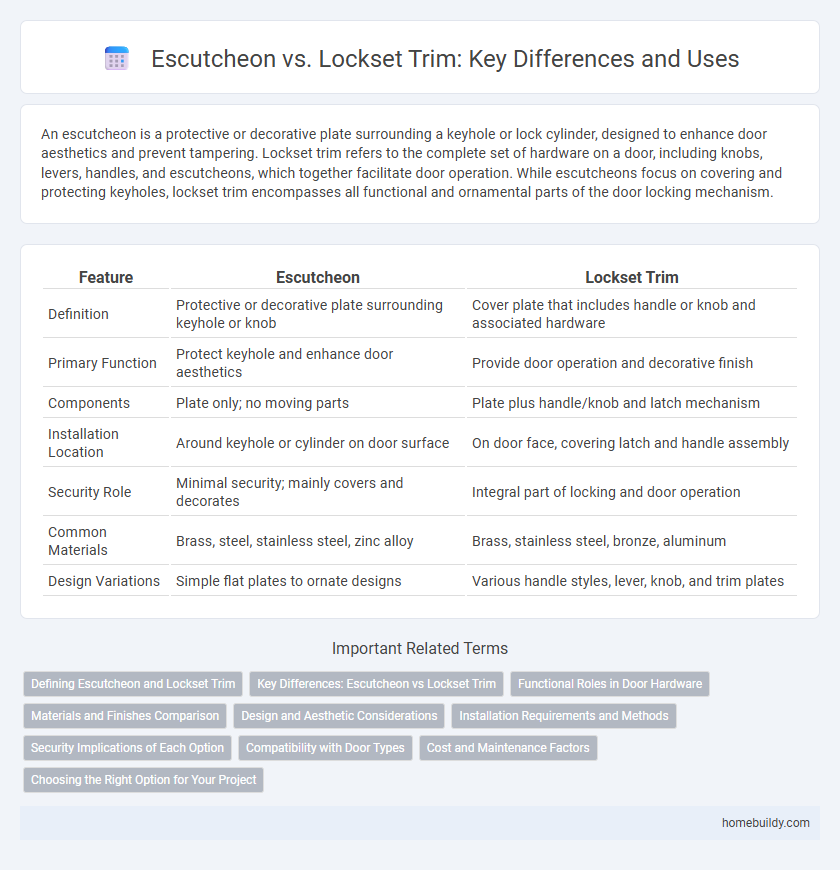An escutcheon is a protective or decorative plate surrounding a keyhole or lock cylinder, designed to enhance door aesthetics and prevent tampering. Lockset trim refers to the complete set of hardware on a door, including knobs, levers, handles, and escutcheons, which together facilitate door operation. While escutcheons focus on covering and protecting keyholes, lockset trim encompasses all functional and ornamental parts of the door locking mechanism.
Table of Comparison
| Feature | Escutcheon | Lockset Trim |
|---|---|---|
| Definition | Protective or decorative plate surrounding keyhole or knob | Cover plate that includes handle or knob and associated hardware |
| Primary Function | Protect keyhole and enhance door aesthetics | Provide door operation and decorative finish |
| Components | Plate only; no moving parts | Plate plus handle/knob and latch mechanism |
| Installation Location | Around keyhole or cylinder on door surface | On door face, covering latch and handle assembly |
| Security Role | Minimal security; mainly covers and decorates | Integral part of locking and door operation |
| Common Materials | Brass, steel, stainless steel, zinc alloy | Brass, stainless steel, bronze, aluminum |
| Design Variations | Simple flat plates to ornate designs | Various handle styles, lever, knob, and trim plates |
Defining Escutcheon and Lockset Trim
An escutcheon is a protective or decorative plate surrounding a keyhole or lock cylinder, often designed to shield the door from wear and enhance aesthetic appeal. In contrast, lockset trim encompasses the entire assembly of exterior hardware components--such as handles, knobs, or levers--that operate the lock mechanism. While the escutcheon serves a specific functional and visual role focusing on the lock itself, lockset trim includes all elements that contribute to both the lock's usability and the door's overall design.
Key Differences: Escutcheon vs Lockset Trim
Escutcheons serve as protective plates surrounding keyholes or lock cylinders, enhancing security and aesthetic appeal, whereas lockset trims encompass the entire decorative hardware set, including handles, knobs, and rosettes. Escutcheons are typically more compact, focusing on safeguarding the lock mechanism from tampering and wear, while lockset trims provide both functional operation and stylistic design for a door. Understanding the distinction between escutcheon plates and lockset trim components is essential for selecting the appropriate hardware to match both security needs and architectural style.
Functional Roles in Door Hardware
An escutcheon primarily serves as a protective and decorative plate around a keyhole or lock cylinder, whereas a lockset trim encompasses the entire hardware assembly, including handles, knobs, and faceplates, facilitating door operation and security. Escutcheons enhance door aesthetics and safeguard lock components from wear and tampering, while lockset trims provide the necessary interface for user interaction and locking mechanisms. Understanding these functional roles is critical for selecting appropriate door hardware solutions tailored to security, durability, and design requirements.
Materials and Finishes Comparison
Escutcheons are typically made from solid metals like brass, stainless steel, or zinc alloy, offering durability and a polished appearance, whereas lockset trims may incorporate a broader range of materials including plastic and composite metals for cost-efficiency. Finishes for escutcheons often feature high-end plating options such as chrome, nickel, or oil-rubbed bronze, providing enhanced corrosion resistance and aesthetic appeal compared to standard lockset trims that frequently use painted or powder-coated finishes. The superior material quality and finish options in escutcheons contribute to longer-lasting hardware with a more refined look than most lockset trim components.
Design and Aesthetic Considerations
Escutcheons offer a sleek, minimalist design that highlights the door hardware while maintaining a clean surface around the keyhole or lockset. Lockset trims often feature more elaborate shapes and details, serving as a decorative frame that complements the overall door style. Choosing between escutcheons and lockset trims depends on the desired aesthetic balance between simplicity and ornamental appeal in interior or exterior door designs.
Installation Requirements and Methods
Escutcheons require precise alignment during installation to ensure secure coverage of keyholes or cylinder faces, often mounted with screws or adhesive backing depending on the material. Lockset trim installation demands compatibility with the internal lock mechanism, necessitating careful measurement and sometimes additional hardware for proper engagement and function. Both escutcheons and lockset trims must be installed on properly prepared surfaces to maintain security integrity and aesthetic consistency.
Security Implications of Each Option
An escutcheon provides a protective plate that covers the keyhole, enhancing security by preventing tampering and drilling around the lock mechanism. Lockset trim, while offering aesthetic appeal and ease of use, may lack the robust shielding found in escutcheons, potentially exposing vulnerable parts of the lock. Choosing between an escutcheon and lockset trim depends on prioritizing either reinforced protection against forced entry or stylish door hardware finishes.
Compatibility with Door Types
Escutcheons provide versatile compatibility with various door types, including wooden, metal, and glass doors, due to their adaptable mounting designs and sizes. Lockset trims, while often designed for specific lock mechanisms, may have limited options for unconventional or custom door materials. Selecting an escutcheon enhances compatibility across diverse door frames, ensuring seamless integration without compromising security or aesthetic appeal.
Cost and Maintenance Factors
Escutcheons typically cost less than lockset trim due to simpler designs and fewer components, making them a budget-friendly option for door hardware. Maintenance of escutcheons involves occasional cleaning and tightening of screws, whereas lockset trims often require more frequent adjustments and lubrication because of their integrated locking mechanisms. Choosing escutcheons can reduce long-term upkeep expenses and simplify repairs compared to the more complex lockset trims.
Choosing the Right Option for Your Project
Escutcheons provide a sleek, minimalistic cover for keyholes and door hardware, ideal for projects emphasizing clean design and easy maintenance. Lockset trims, often more elaborate and decorative, offer enhanced protection and style, making them suitable for traditional or detailed architectural themes. Evaluating the aesthetic goals and functional needs of your project ensures selecting between escutcheons and lockset trims delivers both security and visual harmony.
escutcheon vs lockset trim Infographic

 homebuildy.com
homebuildy.com